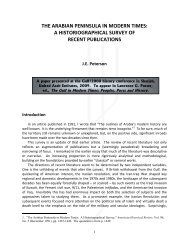Chatty, Dawn, and J.E. Peterson. “Oman” Carol R ... - JEPeterson.net
Chatty, Dawn, and J.E. Peterson. “Oman” Carol R ... - JEPeterson.net
Chatty, Dawn, and J.E. Peterson. “Oman” Carol R ... - JEPeterson.net
Create successful ePaper yourself
Turn your PDF publications into a flip-book with our unique Google optimized e-Paper software.
A group of Bedouin eat a meal. Omani cuisine revolves around rice.<br />
daughters, <strong>and</strong> husb<strong>and</strong>s) to cousins <strong>and</strong> more distant<br />
relatives. These rules apply to fixed property<br />
<strong>and</strong> capital. In the interior among the pastoral<br />
tribes, women often pass on their share of certain<br />
large livestock (camels) to brothers or sons, in exchange<br />
for informal welfare security in their old<br />
age.<br />
Kin Groups. Omani culture is organized around<br />
the kin group as a large extended family or tribe<br />
inhabiting a particular valley or set of hamlets.<br />
There are also dispersed kin groups, the pastoral<br />
tribes, who move around with their livestock in<br />
search of grazing l<strong>and</strong> in a territory normally regarded<br />
as theirs to use. Life revolves around the kin<br />
group in the interior of the country, while in the<br />
urban centers the extended family or tribe is the hub<br />
<strong>and</strong> locus of much activity <strong>and</strong> <strong>net</strong>working.<br />
SOCIALIZATION<br />
Infant Care. Omanis do not separate the infant or<br />
child from family rhythm or routine. The newborn<br />
child remains exclusively with her or his mother for<br />
the first forty days after birth. After that the infant<br />
sleeps, eats, <strong>and</strong> plays at her side, <strong>and</strong> is nursed on<br />
dem<strong>and</strong> for two years. Infants are not offered particular<br />
stimulation, but soothed <strong>and</strong> calmed <strong>and</strong> encouraged<br />
to watch rather than interact.<br />
OMAN<br />
1686<br />
Child Rearing <strong>and</strong> Education. After the age of<br />
two, Omani children are encouraged to behave like<br />
miniature adults, taking on duties or hospitality<br />
toward guests at a very young age. They are only<br />
reprim<strong>and</strong>ed, ever mildly, occasionally with a tap<br />
across the back of the legs. They are socialized to<br />
look to their peer group. Punishment for unusual or<br />
unacceptable behavior is often offered as: ‘‘What<br />
would your friends say?’’ Girls are circumcised<br />
with little ceremony at or just after birth <strong>and</strong> boys<br />
are circumcised in later childhood with some celebration<br />
of their entering an age of ‘‘reason.’’<br />
Primary education for both boys <strong>and</strong> girls is<br />
encouraged. In the later intermediary <strong>and</strong> high<br />
school years, however, attendance by girls, particularly<br />
in rural areas, declines, largely due to a persistent<br />
pattern of early marriage. Many boys also<br />
leave school before the end of their secondary education<br />
in order to seek jobs, thus contributing to a<br />
large low-skill sector of the workforce. The government<br />
also operates a number of vocational training<br />
institutes.<br />
Higher Education. In 1986, Oman opened its first<br />
university. Built upon a combination of American<br />
<strong>and</strong> English models of higher education, the first<br />
colleges were of medicine, engineering, science, Islamic<br />
studies <strong>and</strong> education, <strong>and</strong> agriculture. In the







